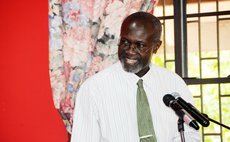A Review of a Tale of Slavery: The Musical
Two weeks ago I was treated to a wonderful theatrical production written by the talented teen Gizelle Pierre-Toussaint and directed by Alwin Bully, Dominica's best and leading Caribbean artist for many decades. This was actually part two of a tale we are all aware of-the tribulations of slavery. So what was different about this piece? Well, my response would be that it was a combination of the insights of a youthful genius and the work of a seasoned campaigner as director.
The stage design was simple but interesting; it presented two worlds that of the 'whites' and that of the 'blacks 'and in the centre, the Unity Church a tool for enslavement, hope, and eventual liberation. The presence of Jabarl, the pastor and elder in the village/plantation is played by veteran Julian Benjamin as he sought to inspire the people's desire for freedom with speeches, biblical quotes, and Negro spirituals to quench thirsty spirits. On stage, a plot is being formulated by the masters/ plantation owners to get the Negros to self-destruct by putting lighter skinned blacks against the darker ones, the house slaves against the field slaves, and creating an atmosphere of jealousy and contentiousness aimed at dividing them .
The tale, as told by Jabarl, continues with Haben expertly portrayed by Caribbean Vibes lead vocal talent Sylas Joseph who not only watches his friend's back but that of his entire family-sister Amina-Athenia Ambo, Jabarl's wife (Rosa-Nickez Bannis) and their son JERLANI who was schooled to take over the leadership of the 'slaves'.
During the tale and events relayed by Jabarl, he had premonitions of his death claiming the ancestors were speaking to him. He did not take too kindly at first to the news that his daughter Amina was developing a love relationship with the sworn enemy- a white man who it was felt could never be trusted.
Haben-Sylas Joseph, always seem to be strategically placed to view the intimate moments of the courtships of Livie professionally executed by Ordovick and Aminah (Athenia Ambo). These courtships were heightened when Levie asked Athenia for her hand in marriage and serenaded her with his guitar to the delight of the audience-such romance!
Meanwhile the villain, the deceptive and cunning Uncle Graugnaud was doing all he could to put the blacks against blacks as he skilfully manipulated complexion, tone, beauty, and the 'privileges' of being a house slave as opposed to a field slave by playing on the sentiments of one slave to another. All of a sudden he convinces Ester, a house slave played by Sondra Latouche that her friend Myrtle played by Eva- Peltier is no longer "equal" to her. The subtle touches of the faces of the coloured damsels, and even the buttocks, were enough for the imagination as the coloureds were seen as mere sexual objects or "dirt".
The foreshadowing of Jabarl's death at the hands of Graugnaud under a hail of thunderous sound and lighting effects set the pace for the rise of Jelani but not before Jabarl's acceptance of sister's choice of Levie who claimed that black blood flowed through his veins.
Jerlani now a grown powerful man formed an alliance with Levie in pursuit of freedom for coloured folks after all his wife Aminah was black! The Negro spirituals sang at church now took on urgency as Jerlani a militant leader move the 'congregation' to fight for their liberty citing that we are all equal. Stage centre is then transformed from church to a meeting place where protest and speeches are enunciated toward the liberation cause. The first confrontation of white guns versus a people's will and black determination left the latter defeated and nursing injuries.
Meanwhile, the most dramatic, emotional and fast paced scene of the production was the confrontation between Levie and the villain everyone loved to hate, Uncle Graugnaud (Jay Grimner) who was stunned into disbelief when he was told that his nephew was born of a black woman.
This LIBRA Foundation Musical tale of Slavery was interspersed with wonderful choreography by a trained Martinique who has a degree in classical and modern dance from Paris. The body language, the use of simple props as the lazy bench really brought a new dimension in the actor and actresses such as Aminah-Athenia Ambo who stood out in her dance solo routines and interpretations. The negro spirituals, live piano and haunting acoustic guitar riffs in between scenes, in harmony with fantastic vocals as Jerlani (Webster "De Webb" Marie) , Haben-Sylas Joseph and Levie-Ordovich all created a realistic mood.
It's not the first time I have seen a play where churches or congregations are involved, but it's the first that I have seen the director has intentionally made the patrons feel part of the act by letting the congregation back be to the audience so one can have the preacher speaking to actors and patrons alike-it worked! So did the effectiveness of switching scenes when thing reached boiling point-innovative
The inclusion of a blood-drenched, dripping neck with a more realistic image of Jabarl may have made his death more hideous and sensational for the spell bound audience. That's the only recommendation which comes to mind to improve this brilliantly executed drama musical written by an early teen, Gizelle Pierre –Toussaint-REMARKABLE!




